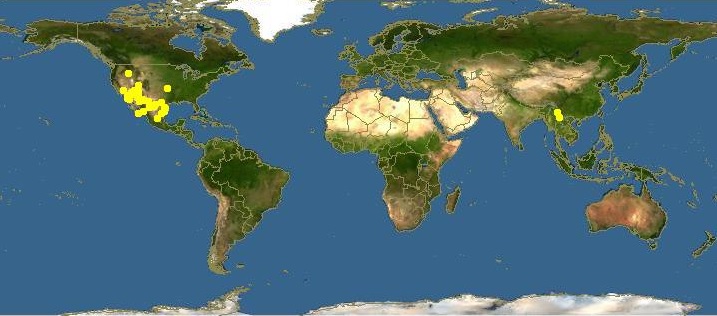Acacia greggii
Contents
General Plant Info
A low shrub which flowers from April to June Common names include Catclaw Acacia, Catclaw Mesquite, Gregg's Catclaw, Devil's Claw, Paradise Flower, Wait-a-minute Tree, and Wait-a-bit Tree; these names mostly come from the fact that the tree has numerous hooked prickles with the shape and size of a cat's claw, that tend to hook onto passers-by; the hooked person must stop ("wait a minute") to remove the prickles carefully to avoid injury or shredded clothing. (Note: "Cat's Claw" is also used to refer to Uncaria tomentosa, a woody vine found in the tropical jungles of South and Central America).
The specific epithet greggii refers to Josiah Gregg, author, explorer, and amateur naturalist of the American Southwest and northern Mexico.
Geographic Distribution
Texas, Arizona, Mexico
Identification
It is a large shrub or small tree growing to 10m tall with a trunk up to 20-30cm diameter. Phyllodes are grey-green, bipinnate, and divided into 1-3 pairs of pinnae, each pinna 2-3cm long with 10-18 leaflets that are 3-6mm. Pinnae are most frequently in two pairs, with the proximal pair perpendicular to the petiolule and the distal pair forming a V at the tip. Flowers are produced in dense cylindrical spikes, each flower with five yellow 3mm petals and numerous yellow 6mm stamens. Pods are flat and twisted, 6-15cm long, containing several hard, dark brown seeds. The seed pod is constricted between seeds
Alkaloid content
Contains N-Methyl-β-phenethylamine, Tyramine[1]
Extraction
Other uses
The Cahuilla and Pima tribes from South Western USA, would eat the raw pods or seeds of the a. Greggii (catclaw), or grind and make mush or cakes. Because the pods are sometimes bitter and slightly alkaloid, catclaw was not a favorite food. When the pods were too bitter, they were parboiled to remove the unpalatable taste.
Pods are used to make an eyewash to treat conjunctivitis. Leaves and pods when ground into powder will stop small amounts of bleeding and soothe chafed skin or diaper rash. When this powder is made into a tea, it can be used as an antimicrobial wash or drunk to treat diarrhea and dysentery. Native Americans used catclaw acacia to soothe sore flank and back muscles of their horses. The flowers and leaves in tea can treat nausea, vomiting, and hangovers. The thick, sticky catclaw acacia root when made into tea treats sore throats, mouth inflammations, and coughs [2]
Cultivation
Suppliers
Links
http://www.fs.fed.us/database/feis/plants/shrub/acagre/all.html
